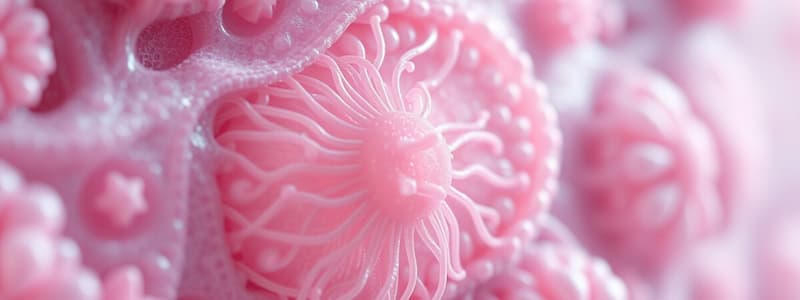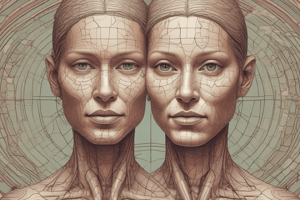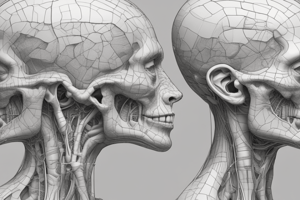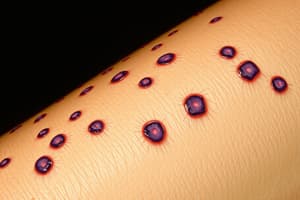Podcast
Questions and Answers
What is the main function of tonofilaments in the Stratum Spinosum?
What is the main function of tonofilaments in the Stratum Spinosum?
- To produce keratinocytes
- To regulate skin pigmentation
- To form a barrier to pathogens
- To connect to desmosomes at the plasma membrane (correct)
Which characteristic is associated with the Stratum Granulosum?
Which characteristic is associated with the Stratum Granulosum?
- Forms the outermost protective layer of the skin
- Consists of maturing cells with keratohyaline granules (correct)
- Contains melanocytes that produce melanin
- Is the deepest layer of the epidermis
What is indicated by the absence or diminished granular layer in the skin?
What is indicated by the absence or diminished granular layer in the skin?
- Normal aging process
- Enhanced melanin production
- Increased skin elasticity
- Ichthyosis Vulgaris, or fish skin (correct)
What type of granules are accumulated in the cells of the Stratum Granulosum?
What type of granules are accumulated in the cells of the Stratum Granulosum?
What protein is found in the membrane surrounding the granular cells of the Stratum Granulosum?
What protein is found in the membrane surrounding the granular cells of the Stratum Granulosum?
What characterizes terminal hairs compared to other types of hair?
What characterizes terminal hairs compared to other types of hair?
Which of the following statements is true regarding vellus hair?
Which of the following statements is true regarding vellus hair?
What is the primary type of hair found on the body of a fetus or newborn?
What is the primary type of hair found on the body of a fetus or newborn?
In terms of structure, which statement correctly describes the hair shaft of vellus hair?
In terms of structure, which statement correctly describes the hair shaft of vellus hair?
Which part of the hair is mainly surrounded by the cuticle?
Which part of the hair is mainly surrounded by the cuticle?
What characterizes the cells in the stratum corneum layer of the skin?
What characterizes the cells in the stratum corneum layer of the skin?
In the context of psoriasis vulgaris, what happens to keratinocyte production and differentiation?
In the context of psoriasis vulgaris, what happens to keratinocyte production and differentiation?
What process describes the continuous replacement of cornified cells in the stratum corneum?
What process describes the continuous replacement of cornified cells in the stratum corneum?
What underlying condition contributes to the thick silver scales observed in psoriasis?
What underlying condition contributes to the thick silver scales observed in psoriasis?
What leads to the development of nonmelanoma skin cancers like squamous cell carcinoma?
What leads to the development of nonmelanoma skin cancers like squamous cell carcinoma?
What type of cells primarily compose the structure of the stratum corneum?
What type of cells primarily compose the structure of the stratum corneum?
Which of the following statements about the stratum corneum is incorrect?
Which of the following statements about the stratum corneum is incorrect?
What main component do the flattened, dead cells in the stratum corneum primarily contain?
What main component do the flattened, dead cells in the stratum corneum primarily contain?
What is the primary purpose of the inner layers of the hair follicle?
What is the primary purpose of the inner layers of the hair follicle?
Which of the following best describes the growth rate of normal hair?
Which of the following best describes the growth rate of normal hair?
What structure primarily surrounds the hair follicle?
What structure primarily surrounds the hair follicle?
How many epithelial layers are formed as hair follicles grow?
How many epithelial layers are formed as hair follicles grow?
Which of the following is NOT a component of the hair follicle structure?
Which of the following is NOT a component of the hair follicle structure?
Which statement accurately reflects the anatomical structure of the hair follicle?
Which statement accurately reflects the anatomical structure of the hair follicle?
What defines the tubular structure of a hair follicle?
What defines the tubular structure of a hair follicle?
Which layers of the hair follicles undergo keratinization?
Which layers of the hair follicles undergo keratinization?
What characterizes the structure of apocrine glands compared to eccrine glands?
What characterizes the structure of apocrine glands compared to eccrine glands?
Which part of the nail is responsible for nail growth and distal movement?
Which part of the nail is responsible for nail growth and distal movement?
What is a primary characteristic of hyperhidrosis?
What is a primary characteristic of hyperhidrosis?
Which structure is covered by the proximal nail fold?
Which structure is covered by the proximal nail fold?
Bromhidrosis is primarily associated with which aspect of apocrine gland function?
Bromhidrosis is primarily associated with which aspect of apocrine gland function?
Which of the following is NOT a feature of eccrine glands?
Which of the following is NOT a feature of eccrine glands?
What is the role of myoepithelial cells in relation to apocrine glands?
What is the role of myoepithelial cells in relation to apocrine glands?
Which of the following correctly distinguishes the nail matrix from the nail bed?
Which of the following correctly distinguishes the nail matrix from the nail bed?
Flashcards are hidden until you start studying
Study Notes
Histology of the Skin and Appendages
- Intermediate Filaments: Tonofilaments or keratin filaments connect to desmosomes at the plasma membrane in the Stratum Spinosum.
Stratum Granulosum (Granular Cell Layer)
- Comprises 3-5 layers of flattened cells that contain dense basophilic keratohyaline granules.
- Filaggrin protein forms the membrane surrounding these keratinocyte layers.
- Secretory granules are present and are not membrane-bound.
- Clinical Correlation: Absence or decrease in the granules leads to Ichthyosis Vulgaris, characterized by hard, rigid skin.
Stratum Corneum (Cornified Layer)
- The outermost layer of the skin, consisting of anucleate, flattened cells filled with soft keratin.
- Cells in this layer continuously shed (desquamation) and are replaced from the deeper Stratum Basale.
- Clinical Correlation: In Psoriasis vulgaris, accelerated production and differentiation of keratinocytes occur, resulting in thickened skin layers and increased keratinization, visible as silver scales. Atypical keratinocytes can lead to nonmelanoma skin cancers like squamous cell carcinoma.
Melanocytes
- Specialized pigment-producing cells located in the epidermis.
Anatomy of Hair Follicle
- Comprised of five epithelial layers; the inner three layers undergo keratinization to form hair shafts, while the outer two layers create internal and external root sheaths.
- Normal hair growth averages 37 mm/day or about 1 cm/month.
- Hair follicles consist of a tubular structure formed by perifollicular connective tissue and epidermal invagination, surrounded by external and internal root sheaths.
Types of Hair
- Lanugo: Fetal or newborn hair, fine and present on the fetus/body.
- Vellus Hair: Fine, light-colored hair; narrow hair shaft with thin inner root sheath located in the upper dermis.
- Terminal Hair: Coarse, thick, and dark hair that extends into the dermis and sometimes into the subcutis.
Sweat Glands
- Eccrine Glands: Coiled and tubular glands responsible for thermoregulation through sweating.
- Apocrine Glands: Less coiled, wider lumen, and more myoepithelial cells; they open into hair follicles and are associated with body odor.
Nail Structure
- Nail Bed: The region under the nail plate.
- Hyponychium: The area underneath the distal part of the nail.
- Nail Root: The proximal part of the nail, covered by the proximal nail fold, extends into the epidermis.
- Nail Matrix: Responsible for nail growth and forward movement through epithelial proliferation and differentiation.
Clinical Correlations
- Hyperhidrosis: Excessive sweating associated with eccrine glands.
- Bromhidrosis: Offensive odor stemming from apocrine gland secretions and associated bacterial activity.
Studying That Suits You
Use AI to generate personalized quizzes and flashcards to suit your learning preferences.




